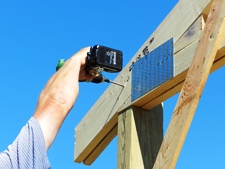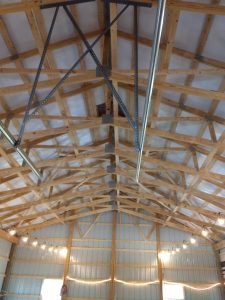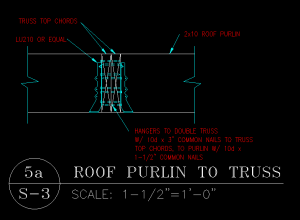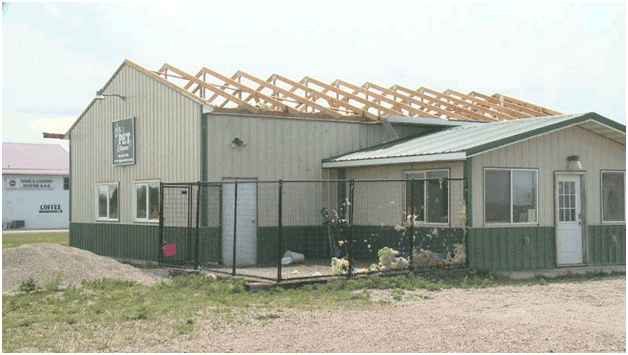As noted yesterday, damaged trusses warrant a repair design by a professional…a licensed engineer. This is not something for “guesswork” or scabbing on a bunch of lumber. First the forces of where damage occurred need to be analyzed, and then only an engineer with solid experience in repairing damages should be engaged to elicit the repair design using appropriate truss connectors.
Fastener selection can often prove to be a challenging exercise, due to the wide variety of truss connectors available. The metal plates used in the manufacture of wood trusses have excellent grip due to the numerous teeth embedded into the lumber. When calculating the quantities of other mechanical fasteners required to repair a damaged plate, it is often surprising to see how much larger the connection areas become.
 Generally, the nail is the most widely used fastener for wood construction. Nails are commonly referred to by penny-weight. Unfortunately, this designation does not have clearly defined dimensions. There may be four or more different nails commonly referred to by a single penny-weight. For example, a 10 penny (10d) nail could refer to a sinker, common, box, cooler or pneumatic (gun) nail, all of which are slightly different. To eliminate confusion, it is important to note nail length and diameter.
Generally, the nail is the most widely used fastener for wood construction. Nails are commonly referred to by penny-weight. Unfortunately, this designation does not have clearly defined dimensions. There may be four or more different nails commonly referred to by a single penny-weight. For example, a 10 penny (10d) nail could refer to a sinker, common, box, cooler or pneumatic (gun) nail, all of which are slightly different. To eliminate confusion, it is important to note nail length and diameter.
Wood screws are another option. Wood screws can have higher values than nails, but often require pilot holes to prevent splitting. Note many general purpose screws, such as deck screws and drywall screws, may share a common gauge number with a heavier wood screw, but are not considered structural due to the lower grade steel used in their manufacture and should be avoided for truss repairs. Recently, specialty screws have become available, resulting in superior performance in relation to standard screws. These screws are manufactured by United Steel Product, Simpson Strong-tie, and Fasten-Master, to name a few.
Machine bolts are generally used where high forces are involved. Truss connectors in wood trusses rarely benefit from high strength bolts, making them unnecessary. Carriage bolts are not recommended; the lack of a washer and solid bearing on the head of the bolt results in poor performance in relation to machine bolts. Lag screws may be used, but are of limited capacity due to the relatively thin (1-1/2-inch) thickness of the truss members. The lack of penetration limits their lateral strength significantly.
The use of adhesives for truss repairs raises considerable debate among engineers. The quality of some adhesives today allow for bonding wood with greater strength than the wood itself, resulting in much smaller connections. However, the conditions under which many truss repairs are performed can compromise the glue bond. For example, freezing temperatures, surface dirt, and unsupervised labor make the capacity of the glued joints difficult, if not impossible, to judge.
Mechanical fasteners can be counted to verify conformance with the repair specification. Unfortunately, once the glue is applied and covered, it cannot be seen without destroying the repair. Therefore, adhesive use is best left for controlled environments, such as factories and jobs where the responsible engineer can observe the application of the adhesives. If an adhesive is to be used, the curing time must be considered. In many instances, a truss must be repaired in place. Once a repair is completed, temporary supports are often removed and construction materials are placed on the truss immediately. This practice does not allow proper time for the adhesive to cure. One solution to this problem is to provide mechanical fasteners, designed to support the construction loads, allowing the adhesive the required time to gain sufficient strength before the full design load is applied to the truss.
One other school of thought is to specify the adhesive, but not to consider it in the calculations. This is most often done when repairing floor trusses. The mechanical fasteners transfer the forces and the adhesive provides insurance against squeaks. If the adhesive is omitted, the repair is still valid. If it is used, it only adds strength and stiffness to the repair.
A common practice used by many engineers to reduce the connection size is to “clinch” the nails used with gussets. In order to properly clinch nails, a gusset is placed on each face of a single ply truss. The gusset must be clamped or held in place securely during the nailing procedure. Nails are driven through the front gusset, through the truss, and through the gusset on the back face. The nails must then be bent over flat against the surface of the back gusset. Please bear in mind clinching must be performed properly. Unfortunately, many repairs specifying clinched nails are performed incorrectly at the jobsite.
Due to the lack of code provisions governing truss repairs, engineering judgment becomes critical in the determination of what is acceptable. While the design capacities of various materials are available to aid an engineer’s calculations, there are times when repairs tend to bring the art of engineering to a level almost equal to the science. Need a truss repair? Call an engineer experienced in designing repairs for damaged trusses. I always have, and always will. Like concrete finishing, there are just some things best left to the experts.









